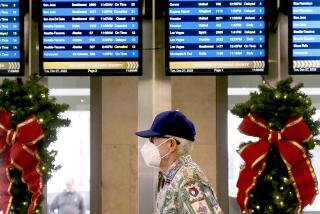L.A. County teachers, essential workers could begin getting COVID-19 vaccine within weeks, officials say

Some Los Angeles County teachers, food workers and first responders could begin receiving COVID-19 vaccinations in two to three weeks — a major step as the populous region works to ramp up its immunization rollout.
However, with supplies of the Pfizer-BioNTech and Moderna vaccines expected to remain tight in the weeks to come, and with the majority of L.A. County’s seniors still waiting to receive their shots, officials warned it will take time for large numbers of educators, child-care workers, food and agricultural employees, and emergency services and law enforcement workers to receive their shots.
The details of how to expand vaccine eligibility to these groups is still being worked out, such as having schools and districts offer their own vaccination clinics.
“With very limited vaccine supply and uncertainty in the timing for increased production, a realistic and carefully developed plan for expanding vaccination availability to these additional sectors is being developed,” L.A. County Public Health Director Barbara Ferrer said Wednesday. “We plan to start vaccinations for workers in these sectors two to three weeks from now.”
More than 1.3 million Angelenos who work in those fields would be eligible to be vaccinated. They include about 668,000 teachers, child-care workers and other educators; at least 548,000 food and agriculture workers, which include grocery store employees; and about 155,000 workers in law enforcement, the courts and dispatch offices.
About 2.2 million people in L.A. County who work in healthcare, live in long-term care facilities or are 65 and older are already eligible.
But only a fraction of those eligible have received at least one shot. Ferrer said about 80% of senior Angelenos have yet to receive a single dose, and both vaccines require two shots, taken weeks apart.
Of the roughly 4.4 million doses L.A. County would need to vaccinate all those currently eligible, the county has received only 1.28 million doses, 1.05 million of which have been administered as of last week.
Ferrer said it was time to expand eligibility, despite concerns that opening up more groups to the queue would make it harder for seniors to get appointments.
“We do have to get started with some of our essential workers. It’s going to be really difficult to wait weeks and weeks and weeks until we complete an entire sector before we move on,” she said.
Unfortunately, supply of vaccine to L.A. County is expected to be limited for a number of weeks, with officials expecting only 200,000 doses a week, split between first doses and second doses. Officials, however, have expressed hope that the vaccine shortage will ease in the coming months, with the Johnson & Johnson single-dose vaccine expected to become available in March, and two other vaccines on the horizon.
“So for now, it will take us time to reach everyone. And in these times of vaccine scarcity, we do need to ask that everyone be mindful of waiting for your turn,” Ferrer said.
The debate over when to add more people into the vaccine line has been occurring across the state.
Some officials have warned opening up shots immediately to teachers, food workers or other first responders will take away limited appointments from those most likely to die from the disease.
Orange County will continue to focus on seniors 65 and older for the next two weeks, Dr. Clayton Chau, director of the Health Care Agency and health officer for the county, said Tuesday. Other groups already eligible for the vaccine there are healthcare workers, residents of long-term care settings and law enforcement employees who work in areas with high COVID-19 rates, such as Anaheim and Santa Ana.
“Adding more people [to those eligible to get the vaccine] will give the seniors less opportunity to get vaccinated,” Chau told the county Board of Supervisors on Tuesday. “And I just want to remind folks that they are the most vulnerable population.”
More than 70% of people who have died of COVID-19 in California have been 65 or older.
Orange County has California’s second-largest population of seniors, with more than 500,000 of them, behind that of Los Angeles County, Chau said. Only an estimated one-quarter of seniors in Orange County have received the vaccine, Chau said.
Chau said he was particularly concerned about a lack of vaccinations administered among seniors living in poor neighborhoods , particularly in Santa Ana, Anaheim and Garden Grove, which are heavily Latino and whose residents are more likely to die from COVID-19 than people living elsewhere.
Among seniors who have been vaccinated and whose information is logged in Othena, a vaccine scheduling system used by Orange County, Latino and Black senior residents are receiving the COVID-19 vaccine at lower rates compared with their percentage of the population.
“Obviously, we need to concentrate our effort in the Black and Hispanic/Latinx community ... and that’s the plan that we’re moving forward — the next two weeks — to make sure that we outreach to those communities,” Chau said.
Other areas in Southern California that have already opened up shots to those groups include Riverside County and Long Beach, which runs its own public health agency separate from L.A. County.
San Bernardino County has opened up vaccination appointments to law enforcement and emergency service workers and teachers.
But across California, securing appointments has been difficult. And other counties have defended their decisions to continue the focus on seniors.
In San Diego County, seniors make up 90% of COVID-19 deaths and the majority of hospitalizations, the chairman of the county Board of Supervisors, Nathan Fletcher, said at a news conference last week.
“For a senior, COVID-19 can be a death sentence. And so right now we are doing seniors,” Fletcher said. “Immediately after that, then we go to the first tier of essential workers, which is law enforcement and teachers.... We do not believe it would make sense to take a senior out of line and replace that senior with a young and healthy worker.”
Fletcher said the moment San Diego County begins to detect any slack in demand for vaccines, “then we will stand ready and willing to rapidly open up the appointment system for teachers, for law enforcement and for food and agriculture [workers].”
On Tuesday, the Board of Supervisors rejected a proposal to allow law enforcement officers to receive vaccines.
Dr. Wilma Wooten, the San Diego County health officer, said other counties that are providing vaccines to law enforcement officers are smaller than San Diego. She said law enforcement was next in line to receive vaccines, and she recommended that the board not change its policy, because seniors still are most likely to die from the disease and law enforcement officers represented just 0.2% of people hospitalized with COVID-19.
Ventura County has taken a more conservative approach than its neighbors and had limited vaccinations to people 75 and older and healthcare workers. Officials there on Tuesday opened up vaccinations to those 65 and older.
“I want to thank everyone in that age range for their patience,” said Linda Parks, chairwoman of the county Board of Supervisors, who added that the county “really prioritizes those who are most vulnerable.”
In the Bay Area, San Francisco officials said Tuesday that they will be ready to open up vaccination appointments to educators, food workers and first responders on Feb. 26. Alameda County has already expanded access to those groups.
So far, San Francisco Mayor London Breed said, more than 30% of San Franciscans 65 and older have received a first dose.
Other Bay Area counties have not yet opened up access to educators or food workers, including Santa Clara, Contra Costa and San Mateo counties.
Gary Warth and Paul Sisson of the San Diego Union-Tribune contributed to this report.
More to Read
Start your day right
Sign up for Essential California for news, features and recommendations from the L.A. Times and beyond in your inbox six days a week.
You may occasionally receive promotional content from the Los Angeles Times.









